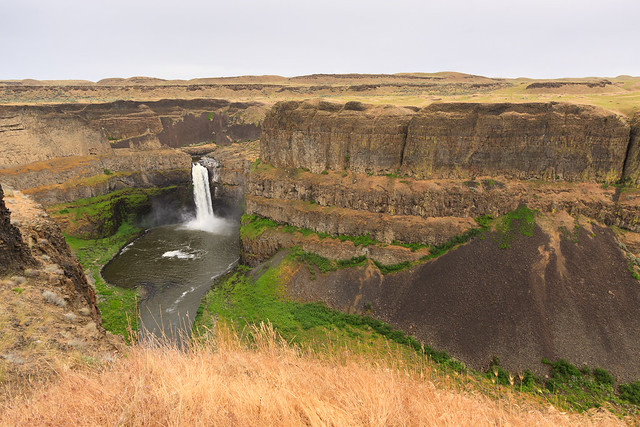There seems to be a trend among people that when you live in a certain area, you tend to take for granted your proximity to tourist attractions and not visit them. Local attractions aren’t really a priority because they’re always there, so you can always visit them later. Well, later can turn into years. In this case, three years. I’ve gone three years without having visited Palouse Falls despite it being a major attraction in the area. To be fair, Palouse Falls isn’t really on the Palouse, but it’s an almost 200 foot sheer drop along the Palouse River in central Washington. It takes about two hours to get there from Moscow, and there’s not a whole lot else around it. Thus, it hadn’t been high on my priorities. Nevertheless, I’ve always wanted to see the falls, and I made an excuse to take Erin to go see them this weekend. To make the drive worth the effort, I planned to grab as many geocaches along the way as I could. I think I did pretty well: thirteen in one day.
So, here’s what makes Palouse Falls so special:
That waterfall is nearly 200 feet tall, 198 feet to be precise. If that’s not impressive enough, the falls are less than half the total depth of the canyon. Needless to say, this basalt gorge is pretty neat. The sheer canyon cliffs remind me of the sandstone canyons of southern Utah, at least in shape. It’s a very cliche western scenery. Somehow, there are trails that lead closer to the falls and even to the bottom, but with my leg still healing, I wasn’t about to risk an injury. So, we stayed in the safety of the canyon rim.
When I said that Palouse Falls was not on the Palouse, what I meant was that it’s not in the eco-region called the Palouse. The Palouse was a prairie, much of which has been raised for agriculture. It’s a region of lush rolling hills, wheat, canola, and lentil farms, and general awesomeness that looks much like this:

In contrast, there’s a point heading west where the farms end and the scrubby rangeland begins. It’s almost a desert out there with the main flora consisting of sagebrush and fewer grasses. It reminds me of southern Idaho, which is also a sagebrush steppe semi-desert with canyons cutting through the bassalt. I suppose that’s the real attraction. The landscape is beautiful. The towns are not. The nearest town to the falls is Washtucna. There’s a convenience store and a country dive bar. The rest of town is boarded up.
Despite its proximity to almost nothing, the park at the falls is pretty nice. There’s a well-kept lawn for picnics and camping and the trails are well maintained and easy to follow. I thought that the rainy weather would hamper my photography expedition, but I think I got a few nice shots with the wet camera. I’d certainly like to return in better weather, maybe even camp out to get some sunset and sunrise shots at the falls. I’d certainly like to hike down into the canyon once my leg gets better.


